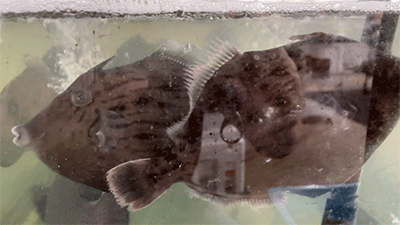| Please access the following URL if you want to secure using SSL. All pages in the site will be secure pages. |
https://secure02.blue.shared-server.net/www.fish-food.co.jp/message english 7.2023.html |
Welcome to FISH FOOD TIMES
July 2023 issue No.235

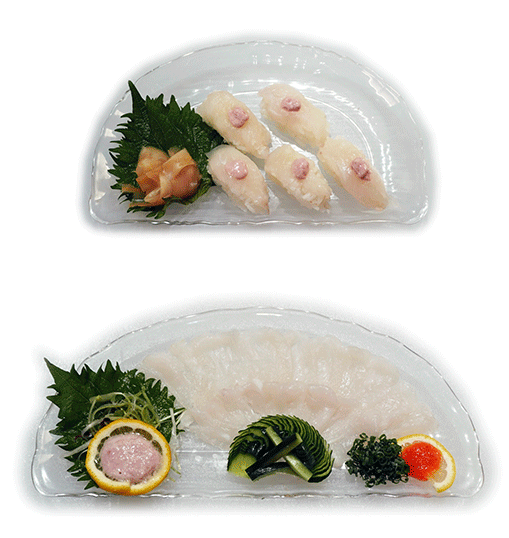
Farmed filefish sashimi & sushi
Farmed threadsail filefish
The unicorn leatherjacket, which is one of the same race of threadsail filefish, was featured in FISH FOOD TIMES July 2019 No.211. Exactly two years later, this time I will be dealing with S. cirrhifer of the family Monacanthidae family Stephanolepis, the genus Stephanolepis, which is the most expensive of the same race of threadsail filefish and called the real threadsail filefish. (Hereafter referred to as file fish) In No. 211, it was written as follows.
As for filefish sashimi, as mentioned above, the January 2006 issue of 15 years ago described unicorn leatherjacket, and the May 2013 issue of 10 years ago No.113 described Black scraper. So far, threadsail filefish has not been taken up as a theme yet, and it may be treated as an article in it. However, if anything, the catch is small and the price is the highest, so aquaculture is attracting more attention than nature, and there is a possibility that aquaculture such as red sea bream and amberjack will become mainstream, so the author wrote in the article. If so, it may be treated from that perspective. |
I wrote like this two years ago, and as a move to actually realize such a description this time, I bought a cultured filefish that was swimming in a live fish tank at a familiar store. This time, I would like to focus on aquaculture and proceed with the article. The video below shows the filefish swimming in the tank before purchasing.
The next image is a filefish scooped out of a live fish tank with a net and still jumping on a cutting board before being subjected to fish nerve tightening. Below that, I added a handheld image of a natural filefish for comparison. By comparison, the farmed ones look plump and the wild ones look leaner and more muscular.
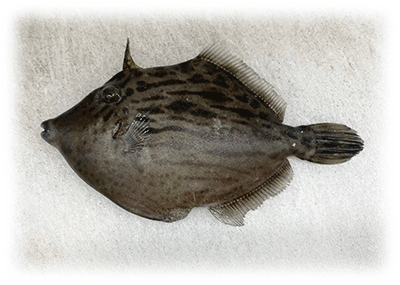
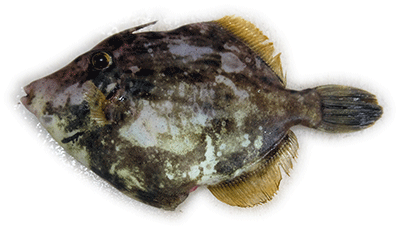
And the following is a cultured filefish that has been about 6 hours since it was brought back from the store after fish nerve tightening, cutting with a deba knife at the base of the neck and tail fin, and then Processing to remove fish blood. As time has passed, the black color on the surface of the fish has faded to some extent, making it a little whitish. Filefish becomes whiter as it loses its freshness, so this change in color can be used as a measure of freshness.
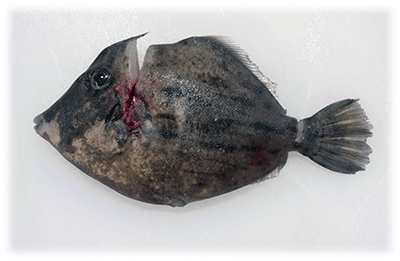
filefish liver
Everyone says that filefish is most valuable in its liver. However, I focus too much on the liver, and the liver grows larger in winter, so it is said that winter is the season, but I think that summer is the season. The reason is that although the spawning season of filefish varies slightly depending on the region, it is mainly around August, and I think that the fish body will be full and delicious from spring to summer before spawning.
However, this is also the story of natural filefish, and in the case of cultured filefish, the liver often grows large even in the summer when the liver is said to be small, which is an advantage of farming. Please see the figure below, which is a presentation material of the Aquaculture Technology Department, Environmental Aquaculture Technology Development Center, Nagasaki Prefectural Fisheries Research Institute. The specific liver weight (ratio of liver weight to fish weight) of wild filefish (about 200 g of fish weight) caught in fishing grounds in Nagasaki Prefecture was about 2% to about 4%. In contrast, the specific liver weight of cultured filefish (about 200g of fish weight) was more than 10% throughout the year.
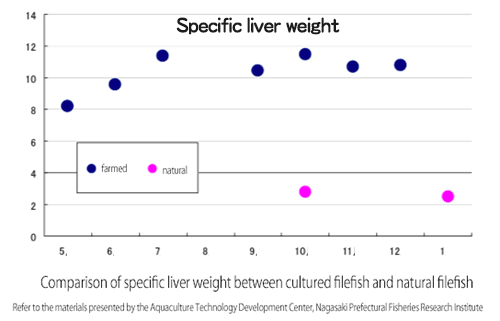
In addition, the fact that farmed filefish grows quickly is considered advantageous for the aquaculture business. In one case, there is a report that after breeding was started in autumn, it grew from 400g to 500g in about one and three months. If such rapid growth can be reliably achieved, farmed filefish will be a very attractive fish species. However, at present, it is common to raise them until the winter of the second year and grow to about 250g to 300g.
Originally, farmed filefish were put in the net to clean barnacles that adhered to yellowtail and greater amberjack farming nets. However, when filefish, which grew together with amberjack and others, were shipped there during the days of the former Tsukiji market, they were traded at a high price. It also has a history of starting filefish aquaculture. Farmed filefish is mainly produced in Kyushu, such as Nagasaki, Oita, and Kagoshima, and prefectures such as Ehime and Wakayama, where yellowtail and greater amberjack are actively farmed.
JR West Japan, a railway company that learned about the appeal of filefish farming, has decided to use a closed junior high school in Izumo City, Shimane Prefecture, as a farming facility from 2022 in collaboration with a company in Shimane Prefecture. And that is where he started his filefish aquaculture business.
The filefish I got this time weighs about 250g, and I bought two fish for 1,200 yen each. This is 4,800 yen/kg, which is equivalent to farmed tiger puffer fish. This price is by no means exorbitant, it is the price that the person in charge of the fish department who is friendly with me made it a little cheaper.
I had fish nerve tightening done at the shop's workshop, and after about 6 hours, I took out the liver in the following way.
| Filefish liver removal method | |
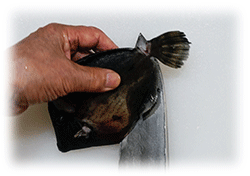 |
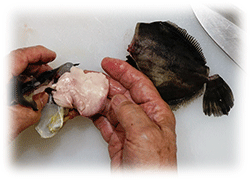 |
| �P�CFirst of all, as the first order of work, make an incision with a kitchen knife between the long bone where the pelvic fin has degenerated and the body. | �U�CCarefully separate the liver with your fingers to avoid crushing other internal organs such as the gallbladder. |
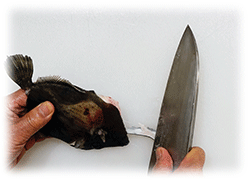 |
 |
| �Q�CHold down the long bone with the base of the knife, pull the fish to the left with your left hand, and separate the body and bones. | �V�CLiver taken out and fish roe still in the growing stage in June. |
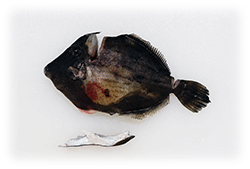 |
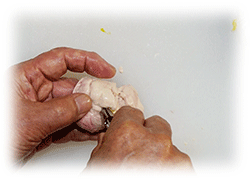 |
| �R�CLong bone separated. | �W�CUse a boning or other tool to remove small, thin blood vessels. |
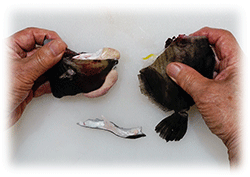 |
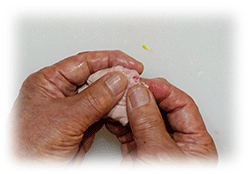 |
| �S�CSeparating the head and body from the blood-drained incision with both hands after removing the long bones in the abdomen makes it easier to remove the liver. | �X�CUse your finger to push out the blood inside. |
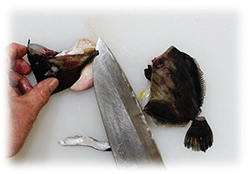 |
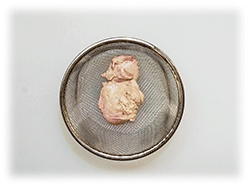 |
| �T�CIf the skin of the abdomen remains, cut it off using the reverse-handed knife method so as not to damage the liver. | 10�CAfter this, the liver will be soaked in water, so put it in a colander. |
Next, in order to use this liver as a topping for nigiri sushi and liver ponzu sauce for sashimi, it is transformed from a block-like shape into an amorphous, crumbling body. This time, the author did not dare to apply heat to the liver. The reason for this is that I was able to obtain extremely fresh livers that had only been a short time since the filefish nerve extraction. Therefore, I decided that it would be a waste to add heat to this with Yushimo or boiling, and decided to enjoy the deliciousness of raw liver.
| Processing work to make liver edible | |
|---|---|
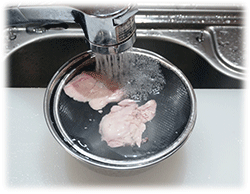 |
 |
| �P�CRinse off blood and dirt by soaking in running water for about 5 minutes. | �U�CThe state of the liver after absorbing water with kitchen paper. |
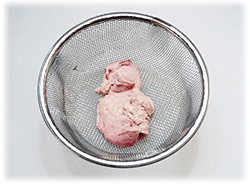 |
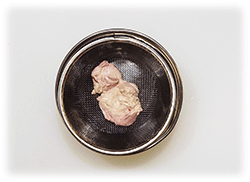 |
| �Q�CLiver after exposure to water. | �V�CPut the liver in a colander again and set it in a bowl slightly larger than the colander. |
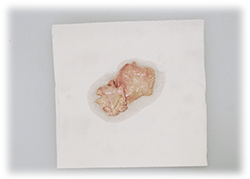 |
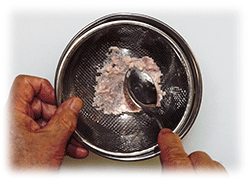 |
| �R�CPlace the liver on kitchen paper. | �W�CSqueeze the liver with a tool such as a spoon and strain the liver into a bowl. |
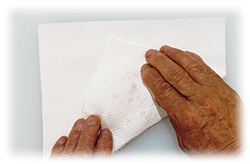 |
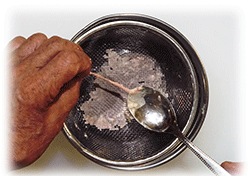 |
| �S�CCover the liver with kitchen paper. | �X�CThe skin of the liver remains in the colander, which is removed and discarded. |
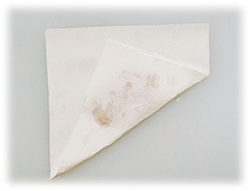 |
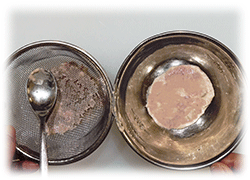 |
| �T�CWrap top and bottom with kitchen paper to absorb moisture. | 10�AThe state of the liver strained out with a colander. |
How to remove mikawa
As the origin of the Japanese name kawahagi comes from the fact that it is a fish that strips its skin, the process of peeling the skin is common for filefish. The process of peeling the skin was introduced in unicorn leatherjacket two years ago in July 2021 No. 211, It's too obvious in a sense, so I'd like to avoid similar duplication this time.
Rather than that, I would like to touch on the "mikawa removal work" that even professionals tend to fail. Filefish mikawa is thin and weak against pulling, and easily cuts in the middle. Also, when this mikawa is cut, it becomes quite a difficult task to remove the remaining part. If you are a fish sales person, you should know this because you have experienced it once or twice. Moreover, because of the small size of the filefish, which averages about 200g to 300g, it is often difficult to remove the mikawa that remains halfway, and there is a high probability that the hand will be taken up with small tasks.
The author moves the yanagiba gently and slowly to remove mikawa using the uchibiki method, but it is not always successful, and failure and cutting is inevitable. Actually, there is a way to reduce this failure, but ironically, it is "not peeling the leather filefish". (In this series of work, the time-lapse function of the overhead camera was again frustrated, and the image was out of focus, so I can't introduce the image.)
Below, we will introduce two cases: (1) with the skin removed and (2) without the skin removed. I will explain how the results came out in two parts.
| Two types of work methods to remove mikawa | ||
|---|---|---|
(1) with the skin removed |
(2) without the skin removed | |
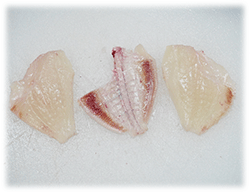 |
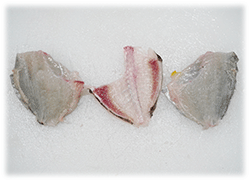 |
|
| 1�Cthree pieces disassembling with common skin removal | 1�CThree pieces disassembling with the skin on | |
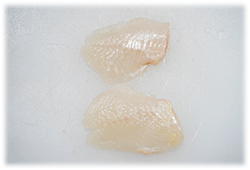 |
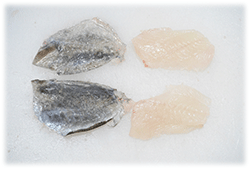 |
|
| 2�CI removed the mikawa by the uchibiki method, but a small amount of mikawa remained on part of the upper body. | 2�CI did uchibiki with the skin still on. | |
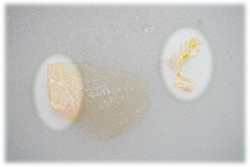 |
 |
|
3�CThe left round circle shows mikawa with the remaining white part, and the right round circle shows mikawa after removal. |
3�Cmikawa does not remain on the fish body, it is attached to the skin | |
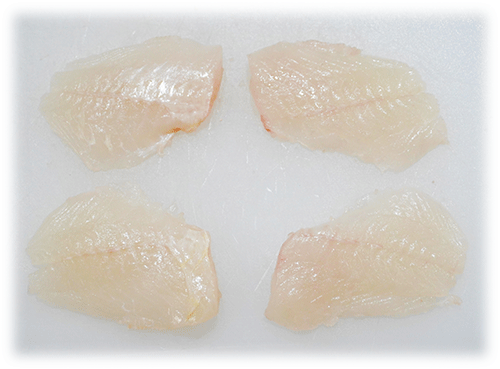 |
||
| The left side of the upper image is the one where mikawa was separated after removing the skin, and a little skin remained on the upper body. On the right side of the image above, the skin was removed while the skin was still attached, but no mikawa remains. | ||
After verifying this result, I felt that it would be less likely to fail if mikawa was left on the body and it was better to remove the leather with �A "Do not peel the leather filefish". However, subcutaneous fat like the glossy skin that appears when fish is skinned (gloss on the surface of the lower part of the upper left of the image above) cannot be expected at all with method (2). Also, since the mikawa will be thrown away along with the skin, it will not be possible to boil the mikawa and add it to the sashimi. In other words, although the work efficiency is good, the amount of waste increases and the cost becomes relatively high.
This time, one mikawa did not exist at all, and the remaining one was half-baked, so I did not boil mikawa and attach it to sashimi.
Expensive filefish sashimi and sushi
We purchased two filefish, each weighing about 250g, for 1,200 yen, and made them into sashimi and sushi. Let's introduce the process below.
| To sashimi and sushi |
|---|
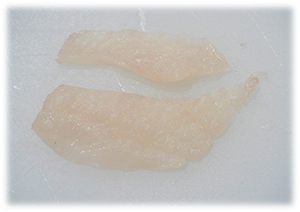 |
| �P�CThe upper body was separated into the back body and the belly body. |
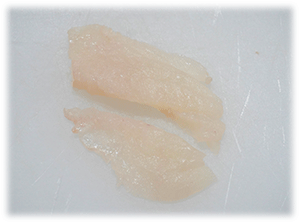 |
| �Q�CThis is back body and belly body of the lower body |
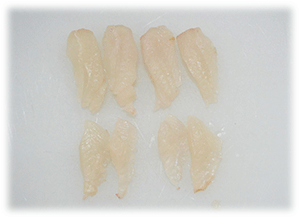 |
| �R�CThe upper four pieces are the back body. The bottom four pieces are the belly body�B |
 |
| �S�COnly the belly body was used for nigiri sushi dane. In order to make 5 pieces of sushidane, 1 piece of sushidane was separately prepared by scraping off relatively thick and thick portions from 4 pieces of belly meat little by little and gathering them together. |
 |
| �T�Cused usutukuri sashimi's method for the back body 4 pieces so that I could make as many as possible. |
In this way, there was one sashimi and one sushi as a work using two filefish. The cost of the product is 1,200 yen when calculating the cost of the fish alone, not including the secondary material cost of the tray and ashirai, so it is presumed that it will probably exceed 2,000 yen when selling at the store.
When asked about the price of 2,000 yen per piece for such a large volume, some people may immediately reject it, saying, "Even though it's a product of this size, if it's that expensive, it won't sell." But this isn't a Black scraper or a unicorn leatherjacket, it's a real filefish. If you eat this nigiri sushi as a product, you shouldn't be surprised if a sushi restaurant charges 1,000 yen per piece. Farmed filefish is not necessarily cheap, and on the contrary, in the summer, you have to be prepared for it to be more expensive than tiger puffer.
The big difference from tiger pufferfish is that filefish can enjoy the liver that cannot be eaten in tiger pufferfish. This time, I dared not heat the liver and used it as a raw liver, and ate it as a topping for nigiri sushi. And the sashimi was mixed with ponzu soy sauce with green onions and grated red leaves, and the raw liver was mixed to make 'liver ponzu'.
Filefish is a high-class fish that weighs less than 300g even if it is large, so it should be regarded as a fish that can be enjoyed by savoring a small amount rather than a fish that can be full in quantity. I can't expect a feeling of fullness even though it takes a lot of work, so I decided to make effective use of Ara in cooking this time.
Boiled Filefish Ara
It would be a waste to throw away the large head of the filefish, so I decided to cook something. Miso soup seemed to be the quickest, but I decided to cook boiled filefish ara instead.
| boiled filefish ara | |
|---|---|
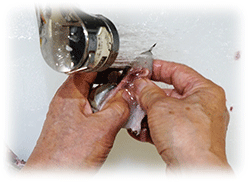 |
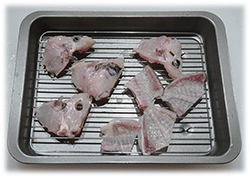 |
| 1�CRemove the skin from the head and wash away the blood with running water. | 8�CAfter wiping off the water, sprinkle with salt and leave it for a while. |
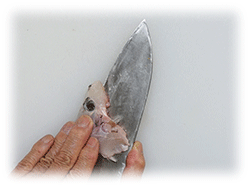 |
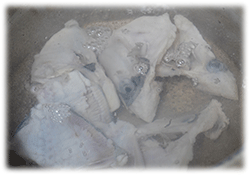 |
| 2�CCut the tip of the Deba knife between two kama(both collar of a fish) | 9�CPut in hot water and yushimo. |
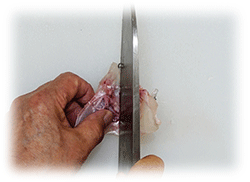 |
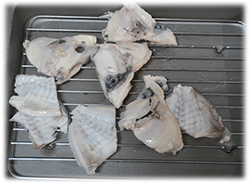 |
| 3�CWith the top of the head down, cut forward with the cutting edge. | 10�CAfter yushimo, wipe off the moisture. |
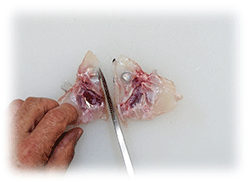 |
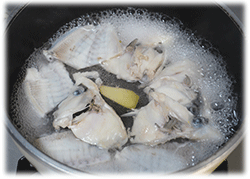 |
| 4�CDivide into two with the top of the head as a boundary. | 11�CPut sake and water in a deep frying pan, bring to a boil, and add ara. |
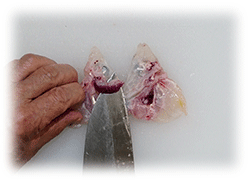 |
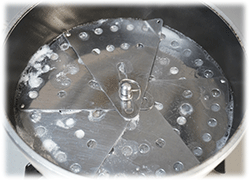 |
| 5�CSeparate the two gills. | 12�CCover with a drop lid and simmer for about 5 minutes, removing the scum halfway through. |
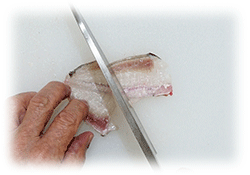 |
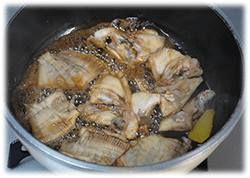 |
| 6�CSplit the centralbone in two. | 13�CAdd 2 tablespoons each of mirin, soy sauce, and sugar, boil for about 5 minutes, add 1 tablespoon of mirin for finishing, and bring to a boil to bring out the shine. |
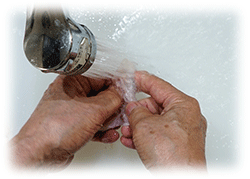 |
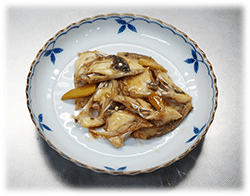 |
| 7�CRinse the ara cut into similar sizes under running water. | Boiled filefish ara is completed |
I made boiled filefish ara, but there was very little to eat, and again, it didn't make me feel full at all. However, the two filefish that I purchased ate the meat attached to the bones of the boiled ara with chopsticks, so it seems that almost all of it was used. I think this is my long-cherished desire as a farmed filefish that is destined to be eaten.
What is the future of farmed filefish?
The cultured filefish was originally cultivated as a cleaner for the aquaculture nets of yellowtail and greater amberjack, but now in terms of the unit price per kg of fish, the leading role and the supporting role have been reversed. The fishermen would never have expected that the filefish would become such a high-class fish, and there may be some anglers in the world who do not know such a thing at all.
I have seen with my own eyes a black scraper being thrown back into the sea from the landing side on a boat pulling up a set net. This is because if black scrape is in the set net, its large horns will damage other fish, especially squid, whose value will drop dramatically if scratched. And since its market price is not very high, it is destined to be treated as a nuisance and thrown away.
Filefish, however, are cultivated with great care and sold at high prices. As mentioned above, JR West's subsidiary JR Innovations and Showa Kaihatsu Kogyo jointly started land-based filefish aquaculture last year at an abandoned school in Izumo City. And about a year later, about four months ago, in March of this year, they started shipping farmed filefish to customers.
The brand name is "Pochakawahagi", but I wonder how much the delivery price will be. I'm curious, but the price will be different for general small purchases such as capital relationships and large business partners, and pricing will be different depending on future strategic directions and how to calculate aquaculture costs.
At an online shop, a set of 4 small plates of 50g filefish sashimi, 4 pieces of 20g liver and skin, and 4 pieces of 30ml ponzu sauce was sold for 15,000 yen. Sashimi alone costs 75,000 yen when converted to 1kg. These are frozen products, but who would buy filefish sashimi at such an expensive price?
In order to compare with tiger puffer fish, I looked at an example of online sales of cultured tiger puffer sashimi. A store sells the same 15,000 yen product, which is not frozen but chilled, and comes in a 130g 30cm platter containing 80g of parboiled skin, 4g of grilled blowfish fin, 150ml of soy sauce, and 4 pieces of 10g of grated maple leaves. If you convert only sashimi to 1kg, this online sale of tiger puffer will cost astonishingly 115,000 yen/kg, which certainly feels expensive. However, since it is an ultra-luxury tiger puffer that is recognized by all Japanese people, some people may think that this price is "well, this is what it is, considering it is cheap to eat at a store..." .
However, I don't think even the same person would rate filefish as highly as tiger pufferfish. The 30 cm large plate looks different from the small plate, and it has a different presence and looks different. The number of accessories is also different, and chilled tiger puffer must be viewed differently from frozen filefish.
What direction will filefish farming take in the future? What will happen to it, whether it will take a super-luxury route similar to tiger pufferfish, or increase its presence at a reasonable price.
The farming of raw salmon is expanding rapidly in Japan, and the currently overly high price of raw salmon shipped by air may be corrected a little in the future. Under such circumstances, I would like to keep an eye on whether filefish farming will expand like raw salmon.
| Please access the following URL if you want to secure using SSL. All pages in the site will be secure pages. |
https://secure02.blue.shared-server.net/www.fish-food.co.jp/message english 7.2023.html |
An opinion and the communication are to iinfo@fish food times
Date of updating 1 July. 2023

